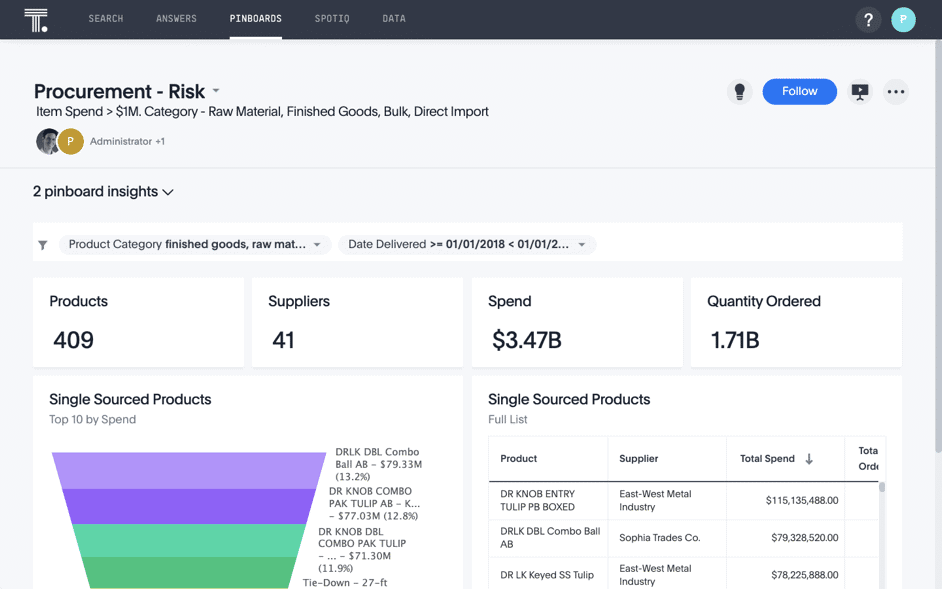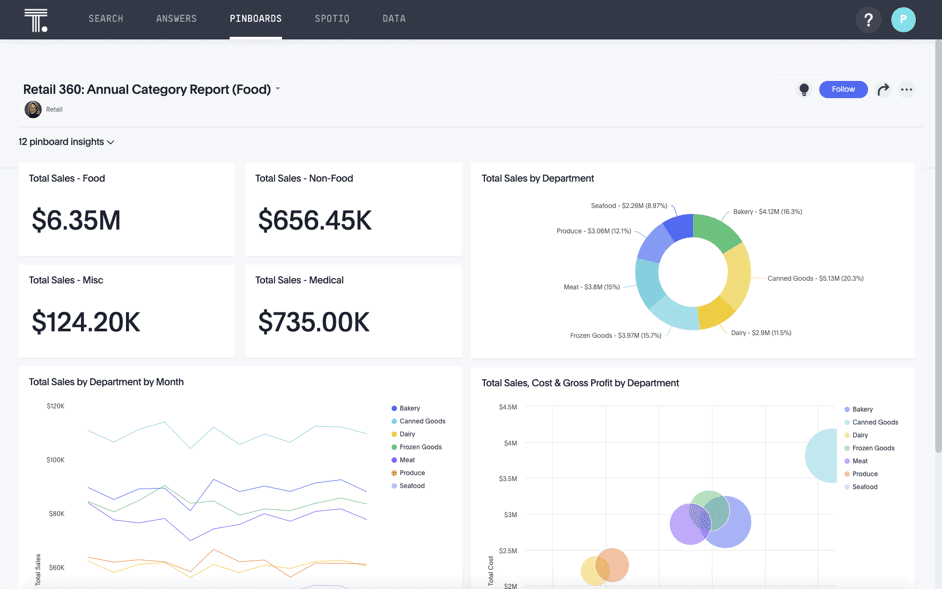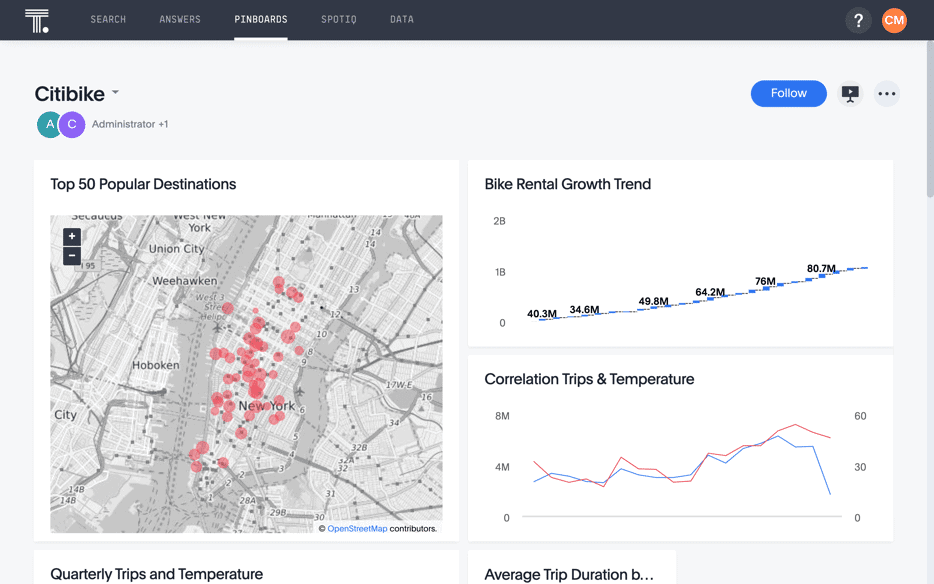The data world is currently experiencing a wave of innovation. Some new IT vendors are disrupting the market. ThoughtSpot and Snowflake are two of those companies. The Business Intelligence (BI) vendor and data warehouse vendor have a strong partnership, as they complement each other.
Many IT professionals know Snowflake. This vendor built a modern data warehouse, added many features, and now speaks of a Data Cloud Platform. Snowflake removes complexity in the architecture and executes multiple workloads on the hyperscale cloud providers. Snowflake promises to deliver the elasticity, performance and scale of the cloud. A previous Techzine blog explains how this works.
Snowflake’s approach made the Data Cloud Platform popular in a short period of time. Many enterprise organizations now use Snowflake, which has led to revenue of hundreds of millions per year. Investors also saw the rise of Snowflake: the valuation of the data warehouse vendor increased enormously due to large investments by Salesforce, among others, and in 2020 it completed one of the largest IPOs of the year.
Also read: Snowflake shares doubled in value on first trading day
Partnerships
As Snowflake plays a more important role in the IT world, we see more IT vendors partnering up with Snowflake. One example is ThoughtSpot. This BI platform has to connect to data warehouse products to execute its role. A data warehouse contains the data Business Intelligence departments use to create graphs and charts. ThoughtSpot, therefore, looks to support as many architectures as possible. In addition to Snowflake, there are, for example, integrations with Amazon Redshift, Google BigQuery and Databricks. Snowflake, in turn, of course, also tries to support as many BI tools as possible, which means that in addition to the connection with ThoughtSpot, all kinds of other combinations are possible.
What makes ThoughtSpot combined with Snowflake interesting, however, is the fact that an investment recently intensified the partnership. Snowflake is putting $20 million into ThoughtSpot, which amounts to about €17 million. We spoke with ThoughtSpot’s CEO, Sudheesh Nair, to determine exactly how we should see this investment. Nair says it’s primarily a strategic move that brings the two IT vendors closer together. “It’s formalizing the partnership through an investment,” Nair says.
According to the CEO, the combination of ThoughtSpot and Snowflake is common. Companies that choose the combination allow the business user without technical knowledge to analyze data through a simple search interface. ThoughtSpot really makes simplifying business intelligence its main priority. If you are curious about how your company can achieve this, read this story about ThoughtSpot we wrote some time ago.

The ThoughtSpot approach and existing partnership have led to joint product innovations. These include Embrace, which allows enterprise organizations to run analytics workloads directly on existing databases without moving or caching the data first. “By supporting Snowflake, the momentum is good. Customers are combining the products and asking for further integration,” Nair says. He sees that the ThoughtSpot-Snowflake combination now not only works as go-to-market partners but also as financial partners.
The stronger partnership is also seen as an opportunity to further the objectives of the ThoughtSpot Cloud, launched late last year. This managed software-as-a-service (SaaS) offering should eventually become ThoughtSpot’s core product. Cloud-only is the goal, confirms Nair. The investment from Snowflake should accelerate achieving this goal. “They are building a Data Cloud. That’s an ecosystem that includes a data marketplace and machine learning models. It allows customers to accelerate their mindset, which happens with the investment,” observes Nair.
The CEO also says the product teams of Snowflake and ThoughtSpot will work together to deliver newer features quickly.
BI transformation
During our conversation, it also becomes clear Nair sees an important role for ThoughtSpot and Snowflake when changing the way business intelligence works. In doing so, he points out what we expect from BI. “BI actually does four things when companies look at data and analytics. The first step is reporting. Once you’ve done that, you start looking for patterns to help you understand the interesting insights. Once you understand the insights, you want to know what model to apply to predict the future. And as a final step, you want to take action based on the predictions.”
According to Nair, those steps cannot be accomplished through traditional BI and human work. In today’s business situations, there is a lot of new data coming in all the time. A simple example is a self-driving car that sends thousands of data points every second. Snowflake is fundamentally different in that respect, Nair argues. The Data Cloud Platform can process data at enormous scale and speeds. “And it can use multiple sources. You can bring in proprietary data combined with weather or traffic data, for example. ThoughtSpot then sits on top of it to take care of the reporting,” explains the ThoughtSpot CEO. In combination with the extensible nature of ThoughtSpot, such as adding additional functionality from the ecosystem or adding BI insights to your own apps through the Everywhere functionality, this should bring BI to a higher level.
It is clear that Nair sees great opportunities for the use of ThoughtSpot in combination with Snowflake. The two IT vendors can take the data strategy of enterprise organizations to the next level. Of course, this can also be done with other products. Therefore, the BI vendor remains fully committed to partnering with other vendors on the database/data warehouse side. Ultimately, each platform has its pros and cons, and it is up to companies to weigh up the pros and cons and choose the right platform.


